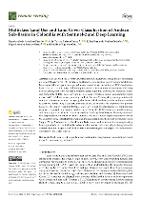Abstract
Land Use and Land Cover (LULC) classification using remote sensing data is a challenging problem that has evolved with the update and launch of new satellites in orbit. As new satellites are launched with higher spatial and spectral resolution and shorter revisit times, LULC classification has evolved to take advantage of these improvements. However, these advancements also bring new challenges, such as the need for more sophisticated algorithms to process the increased volume and complexity of data. In recent years, deep learning techniques, such as convolutional neural networks (CNNs), have shown promising results in this area. Training deep learning models with complex architectures require cutting-edge hardware, which can be expensive and not accessible to everyone. In this study, a simple CNN based on the LeNet architecture is proposed to perform LULC classification over Sentinel-2 images. Simple CNNs such as LeNet require less computational resources compared to more-complex architectures. A total of 11 LULC classes were used for training and validating the model, which were then used for classifying the sub-basins. The analysis showed that the proposed CNN achieved an Overall Accuracy of 96.51% with a kappa coefficient of 0.962 in the validation data, outperforming traditional machine learning methods such as Random Forest, Support Vector Machine and Artificial Neural Networks, as well as state-of-the-art complex deep learning methods such as ResNet, DenseNet and EfficientNet. Moreover, despite being trained in over seven million images, it took five h to train, demonstrating that our simple CNN architecture is only effective but is also efficient.














